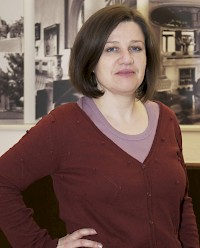Vita
Eva Maria Froschauer studied architecture at the University of Art and Design Linz (Austria) and holds a master of advanced studies in history and theory of architecture (ETH Zurich, Institute gta). Since 1997 she has been working as a free-lance critic and author for several architectural magazines and publications; between 2001 and 2007 she was research assistant at the Bauhaus-University Weimar, faculty of architecture (Gropius-Chair); 2008 PhD in History of Architecture. Since 2009 she is a lecturer at the Brandenburg University of Technology Cottbus and she is a founder member of the Netzwerk Architekturwissenschaft e.V. Here research fields are (historical) media and architecture; travelling as cultural technique for architects; knowledge of architecture. Since October 2011 she is a member of the research fellow program «Tools of Drafting» at the IKKM where she examines the relation between collecting and designing in architecture.
Dated from 2012
IKKM Research Project
«On Collecting and Designing»
The strategies to find and to define an architectural form depend on the use of a variety of tools. Some of those tools are intended to control imagination and the free-floating play of thoughts; they should be able to establish more parameters and therefore more objectivity. Currently the main tools in architectural design are digital tools. Not only since the idea of «datascapes» – the so called collection of facts and figures to define form – could the cultural technique of collecting be identified as a specific tool in creative processes too. Beyond that, the history of architecture offers numerous examples showing that a «collection» may generate initial ideas in design processes.
The starting point of this research project is the examination of different methods of collecting and the architect’s common attitude to act like hunters and gatherers. Collecting is meant as practice of detecting, gaining, and displaying, as practice of establishing storage and archives of knowledge and expertise in architecture. Moreover, collecting can be understood as tool facilitating the practice of design as a projective practice. Design processes themselves are able to create new kinds of assemblages, new methods, strategies, and results.
The approach of this research project is based on case studies. The intention is to show how the technique of collecting will serve the production of knowledge, linked to the approach of designing as artistic practice. Both should be understood as parts of productivity in architecture.
Publications (selection)
»An die Leser!« Baukunst darstellen und vermitteln – Berliner Architekturzeitschriften um 1900, Tübingen, Berlin: Wasmuth, 2010.
Die nützliche Reise, erschienen in der Reihe: Thesis. Bauhaus-Universität Weimar, H. 1, 2003 (mit Ruth Baumeister).
Funktionsweisen der Architektur im Medium. Einige Anmerkungen, in: Umbau, 26, hrsg. von der ÖGFA, Wien: (erscheint 2012).
Giedion und die Fotografie. Die Disziplinierung der Moderne (Rezension zu Werner Oechslin und Gregor Harbusch), in: Bauwelt, H. 39/40, 2011, S. 49.
Architekturzeitschrift. Enzyklopädisches, spezielles, selektives und manifestierendes Wissen, oder: Architektur als vermittelte Mitteilung, in: Wolfgang Sonne (Hg.), Die Medien der Architektur, Berlin, München: Deutscher Kunstverlag, 2011, S. 275-301.
ABCDarium – the World of Building Classified, in: Susanne Schindler, Axel Sowa, Ariane Wilson (Hg.), Constructing Knowledge – Das Wissen der Architektur. Conference Proceedings: RHTW Aachen, 2011, S. 30-39.
Konzepte der deutschen Architekturzeitschrift, in ihren Anfängen und um 1900, in: Burcu Dogramaci, Simone Förster (Hg.), Architektur im Buch, Dresden: Thelem, 2010, S. 13-25.
1907 Hans Bernoulli: Pariser Platz, in: Carsten Krohn (Hg.), Das ungebaute Berlin: Stadtkonzepte im 20. Jahrhundert, DOM publishers: Berlin, 2010, S. 23-25.
Karl Scheffler. Stilmeierei oder Neue Baukunst. Ein Panorama Berliner Architektur (Rezension zu Andreas Zeising), in: Bauwelt, H. 17/18/2010, S. 47.
Berliner Autochthone – die Vermittlung des frühen Werks Alfred Grenanders in der Architekturpresse, in: Christoph Brachmann, Thomas Steigenberger (Hg.), Ein Schwede in Berlin. Der Architekt und Designer Alfred Grenander und die Berliner Architektur (1890-1914), Korb: Didymos-Verlag, 2010, S. 359-374.
Eisenach – Jena – Weimar. Thüringer Städtebaukultur nach 1990, in: Thüringer Ministerium für Bau und Verkehr und der Bauhaus-Universität Weimar (Hg.), Stadtland Thüringen – Wege des Städtebaus, Weimar, 2007 (mit Gernot Weckherlin), S. 156-161.
»An die Leser« – das Berlinbild in den Architekturzeitschriften des frühen 20. Jahrhunderts, in: Jörg H. Gleiter, Norbert Korrek, Sandra Schramke (Hg.), Wirklichkeitsexperimente, Festschrift für Gerd Zimmermann, Weimar, 2006, S. 287-299.
Zum »Thema Berlin« überleiten, in: Klaus-Jürgen Winkler (Hg.), Neubeginn. Die Weimarer Bauhochschule nach dem Zweiten Weltkrieg und Hermann Henselmann, Weimar, 2005 (mit Gernot Weckherlin), S. 127-146.
